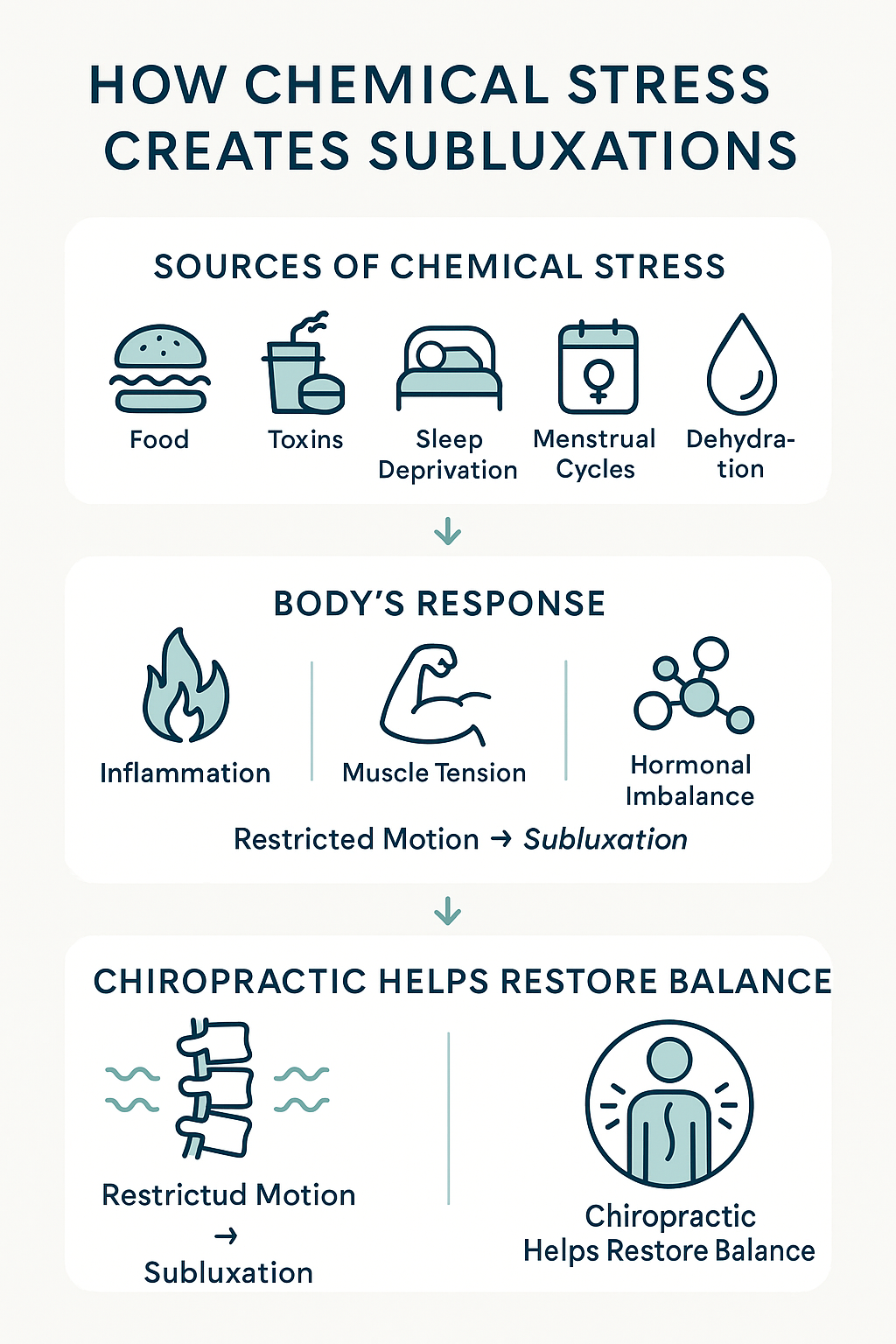Introduction
When most people think of stress, they imagine emotional strain or physical overwork. Yet, there’s another powerful force that quietly shapes the way our bodies function: chemical stress. From what we eat and drink to the way we sleep and even the natural cycles our bodies go through, chemical stress has a direct influence on the nervous system. At our Wellington chiropractic clinic, we often see how these stressors contribute to subluxations — subtle but significant dysfunctions in the way joints move and communicate with the brain.
Understanding Chemical Stress
Chemical stress occurs whenever the body’s natural balance is disrupted by internal or external factors. It may come from eating processed foods, drinking excessive coffee or alcohol, breathing in environmental toxins, or relying on certain medications. But it’s not only about what we consume from the outside. Internal processes also play a role. Hormonal changes, such as those experienced during the menstrual cycle, shift the body’s chemistry in ways that can affect muscles, ligaments, and joints. Similarly, lack of sleep alters cortisol and melatonin levels, placing the nervous system under pressure and reducing the body’s ability to repair and restore itself.
The Nervous System Under Stress
When chemical stress builds up, the body shifts into “fight or flight” mode, activating the sympathetic nervous system. This state may be helpful in the short term, but over time it increases inflammation, elevates muscle tension, and disrupts hormones that control energy and recovery. You may notice this after a poor night’s sleep, when your body feels stiff and your mind sluggish, or during certain points of the menstrual cycle, when aches and changes in posture become more obvious. These aren’t random discomforts — they’re signs of a nervous system struggling to adapt.
How Subluxations Develop
Chemical stress doesn’t physically push bones out of place, but it changes the way muscles, ligaments, and joints behave. Tight or fatigued muscles pull unevenly on the spine. Inflammation stiffens tissues, reducing range of motion. Small strains and injuries don’t heal properly because the nervous system is already overloaded. Gradually, these changes lead to subluxations — joints that no longer move freely and nerves that no longer communicate efficiently with the rest of the body.
The Cycle of Stress and Dysfunction
What makes chemical stress particularly challenging is its cyclical nature. Once a subluxation develops, it interferes with nerve communication. This makes it harder for the body to detoxify, regulate hormones, absorb nutrients, and even establish healthy sleep cycles. In other words, stress feeds dysfunction, and dysfunction feeds more stress.
How Chiropractic Care Supports Balance
Chiropractic care doesn’t detox your body in the chemical sense, but it restores balance by improving joint motion and calming irritation in the nervous system. Adjustments help muscles and joints move more freely, allowing the body to recover from stressors with greater ease. Many people find that, alongside healthy lifestyle habits like quality sleep and mindful nutrition, chiropractic care improves their resilience against the hidden effects of chemical stress.
Takeaway
Chemical stress is often overlooked, but it has a profound impact on the nervous system and spine. From diet and toxins to menstrual cycles and lack of sleep, these stressors quietly shape how your body functions and can pave the way for subluxations. By caring for both your lifestyle and your spine, you can support your nervous system to stay adaptable, resilient, and ready for the demands of life.
If you’re searching for a chiropractor in Wellington who understands the connection between chemical stress and spinal health, the team at Limitless Chiropractic is here to help. Book your check-up today and give your body the support it needs.
References
- Sapolsky RM. Why Zebras Don’t Get Ulcers. Holt Paperbacks, 2004.
- McEwen BS. Stress, adaptation, and disease: Allostasis and allostatic load. Ann N Y Acad Sci. 1998;840:33–44.
- Pickar JG. Neurophysiological effects of spinal manipulation. Spinal Manipulation: State of the Art Reviews. 2002.
- Lelic D, Niazi IK, Holt K, et al. Manipulation of dysfunctional spinal joints affects sensorimotor integration in the prefrontal cortex. Neural Plast. 2016.
- Chrousos GP. Stress and disorders of the stress system. Nat Rev Endocrinol. 2009;5(7):374–381.
Experience Limitless Movement Chiropractic Care in Wellington
If you’re in Wellington and looking for expert chiropractic care, we’re here to help. At Limitless Chiropractic, we focus on helping you move better, feel stronger, and live without limits. Book your appointment today and take the first step toward a healthier, more mobile you!
Ready to begin or continue your healing journey? Let’s work together to unlock your body’s natural potential for wellness.
Book Your Limitless Journey Today
or call us at (04) 891 0911
